The chaos of one night in Frankston Hospital emergency department
IT’S 3.40am — dark, freezing and unusually quiet for the Frankston Hospital emergency department. But within minutes their quiet night takes a turn. Here’s what the medical lifesavers who work in emergency face on a nightly basis.
VIC News
Don't miss out on the headlines from VIC News. Followed categories will be added to My News.
IT’S 3.40am — dark, freezing and unusually quiet for the Frankston Hospital emergency department. But within minutes their quiet night takes a turn.
A coffee van out the front has the attention of excited staff, but their caffeine fix is soon abandoned when all hell breaks loose inside.
The middle-aged woman brought in by paramedics for an overdose is now more intent on fighting help than taking it.
She has taken a dozen prescription pills, washed down with just as many beers. Her muscles are now relaxing dangerously and shutting down her breathing.


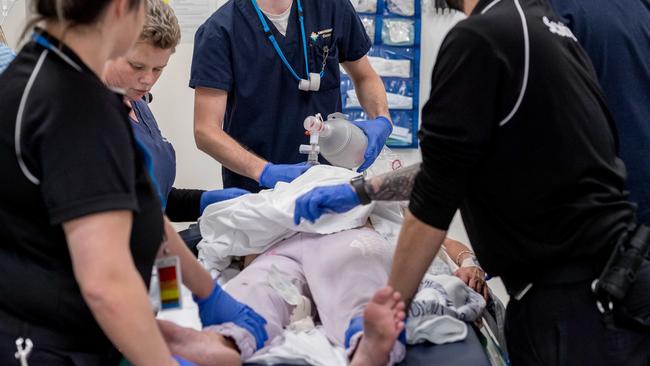

At first it is impossible to understand her slurring, but after being moved to resuscitation bay two her screams become clearer as she begins yelling out “I’m so, so, so, so, so sorry” over and over again.
As the middle-aged woman screams incoherently and kicks out violently two security guards and a pair of nurses do their best to pin her arms and protect the doctors desperately trying to put a breathing tube down her throat.
It’s frenzied, violent and necessary — at least from the medics’ point of view — but the first round goes to the woman.
With amazing calm as their patient continues to thrash the team plot out another plan A, B and C while her vital signs weaken.
After removing the foot of the bed to pin her legs and arms, and trying a different type of sedative, the team can finally hook the woman up to the ventilator she needs to breathe and allow her body to overcome the toxic mix.
Despite her best efforts the woman’s life has been saved and she will soon be moved to intensive care where she is expected to remain in an induced come for two days.
Just 20m away in another cubicle, a “code grey” is called midway through the overdose battle.
Security and nursing staff rush to help a colleague who has just been assaulted by an elderly dementia patient who is confused and highly aggressive.
The 89-year-old had been brought in earlier by police, a case more heartbreaking than criminal.
It had taken four officers to help restrain him on an ambulance trolley after he lashed out at nursing home staff.

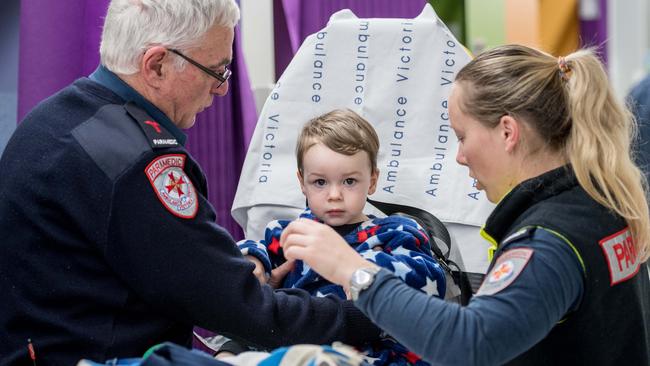
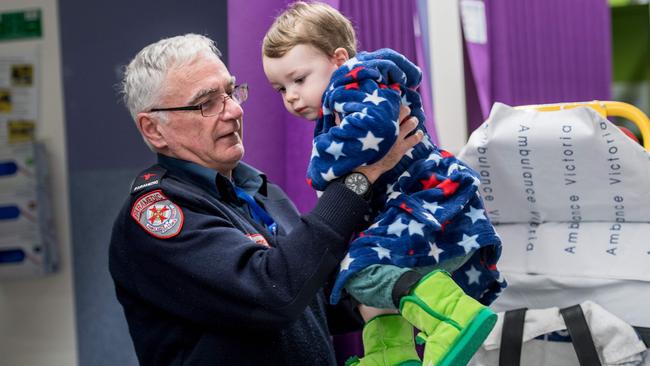
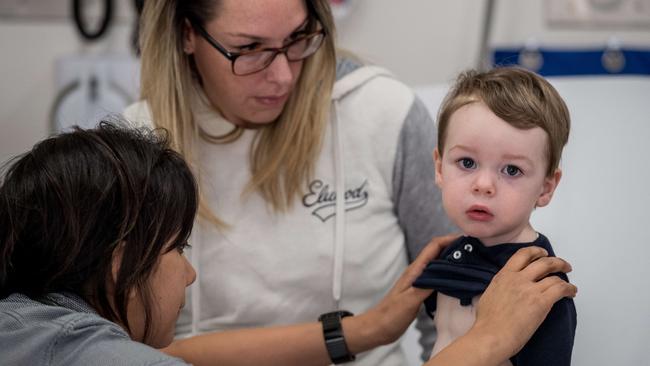
After being sedated and left for a few hours in the hope his episode of confusion will ease he has now grabbed a nurse by the arm and is bellowing loudly.
Everyone wants to calm him again for his own wellbeing as well as theirs.
In between the two hostile cases, behind a curtain in resuscitation Bay 3, an anxious elderly woman can be heard gasping for air and trying to overcome the worsening respiratory problems the same doctors and nurses have been lovingly helping her through for hours.
Amid the action two-year-old Vance Richards arrives, barely big enough to sit up in the ambulance trolley as he is wheeled down the hall suffering his own respiratory issues.
Little Vance has already been in hospital three times for croup — including a stint in intensive care while on a family holiday in Bali — but his current shortness of breath is still horrifying for parents J’nae and Ben.
The family is taken to the other side of the emergency department where it is quiet and given all the attention in the world.
And then there’s the patient who walks in off the street, flanked by his mates.
With a black eye and gaping wound down his cheek, he says he’s run into some issues while having a few beers.
Amid talk of an assault and potential charges he is taken away for treatment.
It’s all a far cry from hours earlier when staff clocked on for their overnight shift.
“We see a huge range of cases and people attached to them, which is probably why we are attached to emergency,” nurse unit manager Elissa Rolland says.
“It’s another person and it’s not about any judgment that this person deserves more care or is more injured than the other.”
At 7pm the ED is busy, but calm. There are 34 patients being treated, which include a critically ill Category 1 patient, 13 Category 2 and 10 Category 3s.
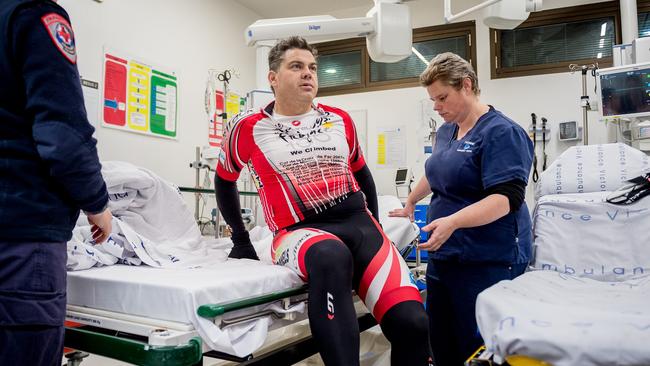
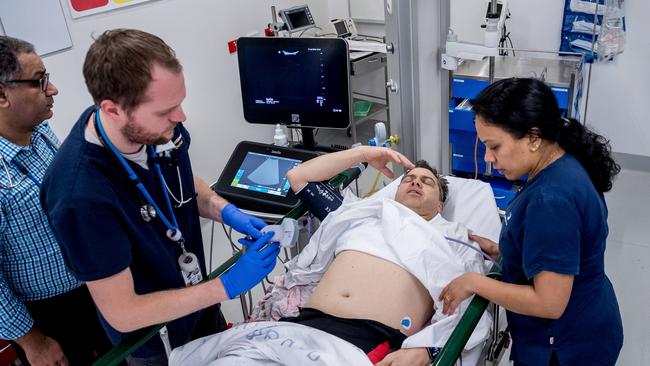
The newly refurbished unit will see about 220 patients on an average day.
“It’s one of the highest in the state, if not the highest of metropolitan hospitals, in terms acute patients,” director of emergency Dr Shyaman Menon said.
“We are not supported by a network of other services as you are in the city … we are proud of having that responsibility.”
Over the next 20 minutes five ambulances arrive, with a mixture of patients, but nothing out of the ordinary.
Fay Turner, 81, has suffered a suspected stroke. She is very anxious and needs sedation to settle, but scans eventually clear her of any severe complications.
A younger woman is offloaded from an ambulance, sitting up sucking on a “green whistle” of pain killers for her abdominal injuries.
The professional bodybuilder has hurt herself in a training accident, but fills the time between treatment taking selfies for social media.
In a much more quiet area Lottie Bartley, 7, is nearing the end to her four-hour visit.
“I was on the slide and I hurt my elbow when another kid pushed me off,” she says.
She clutches a hand-knit teddy, one of hundreds made each year by volunteers to ease the trauma for young patients.
About one in four of Frankston’s emergency presentations are children. Like Lottie, they are treated in the specialised paediatric area away from the excitement of the main ED.
In a nearby bay Marcus Sanders, 11, also has his arm in a sling after a fall playing netball at school.
Thanks to emergency staff — and a strong dose of pain killer — his arm was able to be reset and he won’t have to visit again for further treatment.
Security are called to oversee the transfer of a middle-aged man apprehended by police under the mental health act.
Although initially aggressive, the man is soon snoring in a bay closest to the staff station where he can be easily monitored while recovering from substance abuse.
When he wakes confused and aggressive at 8.45pm a code grey is called, triggering a response from security and a team of consultants keen to de-escalate the situation.
“It is no surprise, this is kind of what we are expecting him to do,” Dr Jonathan Dowling says.
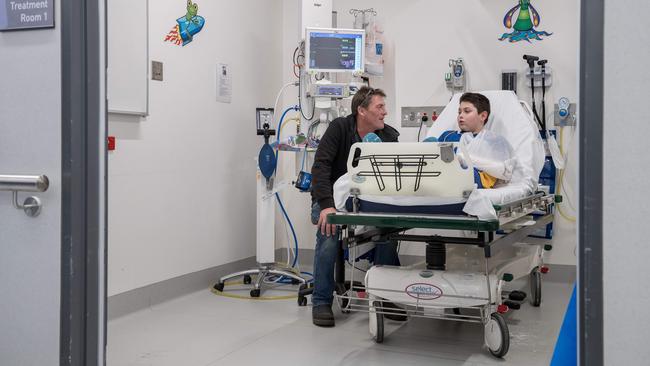
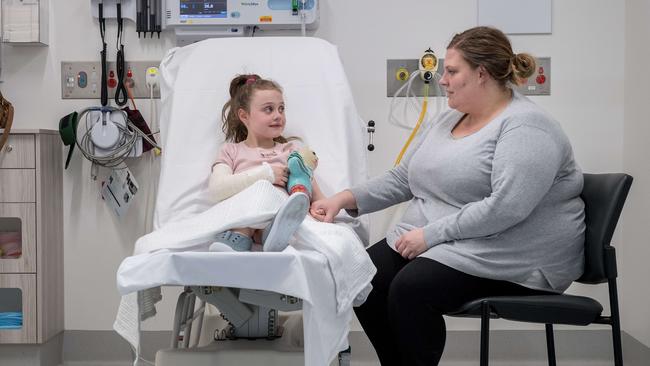

“We knew there was potential for him to act up a little bit.
“While people may come in very agitated and distressed we want to respect their rights. So it becomes a tricky balance between what we can do for them safely while having somebody who may or may not able to make decisions for themselves.”
At 9.06pm an ambulance arrives causing a very different scene.
Susan Qualtrough sits with a brightly wrapped present on her tummy.
“I’m supposed to be having a baby tomorrow … this is a present from the baby to their sister,” Ms Qualtrough explains.
Having put a chisel through his hand a young tradie arrives at the waiting room just before 10pm, only to faint at the triage desk.
He is soon patched up without further issue and able to go home.
By midnight 22 patients are being treated in the ED for everything from cardiac issues to haemorrhoids and complications days after giving birth, another three ambulances are on the way.
Under police escort and with fears for her safety a middle-aged woman is brought in with her community treatment revoked, meaning she will be kept in a mental health unit for 72 hours to be assessed.

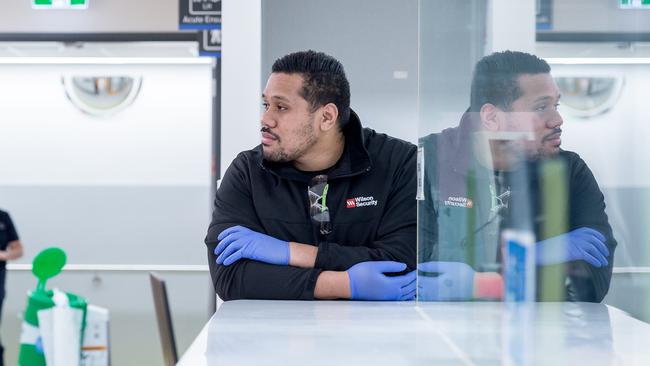
Although preparations are made for a potentially confrontational scene she arrives apologetic and happy to accept help.
“I’m not normally like this,” she insists gently.
An elderly lady arrives shaken and in a neck brace after taking a fall in her bathroom.
Massive bruising is already covering much of her forehead, but she is happy to chat.
“They are taking the best of care for me. They are so nice to people,” she said.
Johannes Schefman, 68, would rather not be at hospital at all, but is also pleased with his treatment since arriving with a chest complaint, fearing a heart attack.
“They are going to do another blood test in a couple of hours, so we’ll see what happens, but I am feeling all right now,” he said.
After the 3.30am rush things settle down again.
By 6.30am the city is rising but Jamie Cartwright’s day has not started well.
He is the 66th patient of the 12-hour shift, having been T-boned by a car while cycling.
Mr Cartwright is considered a trauma case, but he appears relatively lucky, escaping with cuts and bruises.
“The impact was relatively slow, but I remember in slow motion trying to push the car away,” Mr Cartwright tells the doctors.


